Tracking satellites with a solar radiospectrograph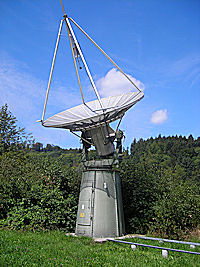
Sven Grahn, Sollentuna, Sweden
The Soviet manned space program
has always been a focal point of the space tracking activities of the Kettering
Group. Of course much of the group's fame has come from monitoring
the Soviet/Russian reconnaissance satellites program, but in my personal
view, this is something we did while waiting for the manned flights! In
the beginning of the manned program the Soviet Union published radio frequencies
of the craft so that the world could listen in and verify the flights.
As they became more and more routine this practice disappeared. When new
elements in the manned spacecraft fleet appeared we were often at a loss
as to which frequency to listen to. This was a problem we discussed constantly.
In the mid- to late seventies several new craft appeared, like the Salyut
3 and 5 space stations (Almaz) and the other craft of the Almaz
system like Kosmos 929 (TKS). Of course, at that time the relationship
between the two Salyut categories and the strange craft represented by
Kosmos 929 was not known.
Dick
Flagg comes up with the idea
So, finding new frequencies
was a priority! When Richard "Dick" Flagg (you can read about our exploits
in tracking Apollo 17 in the piece
"Tracking
Apollo 17 from Florida ") visited me in Stockholm, Sweden in July
1978 he had brought a new idea of how to find frequencies of Soviet spacecraft.
At that time was a radio astronomer at the University of Florida in Gainesville.
He built radio systems for radio astroniomy and was going to Zürich
to install some equipment at the radio astronomy obervatory of the ETH
Technical Univerisity. He had become aware of the fact that the Swiss were
operating a solar radiospectrograph at Zürich operating in the range
100-1000 MHz and recording the signal on film. (As the receiver swept through
the frequency range an oscilloscope beam swept perpendicular to the motion
of the film and the beam was intensity-modulated with the received signal
strength). The 5 meter dish antenna of this instrument was kept pointing
at the Sun by means of motor drive. The receiver that swept through 100-1000
MHz had a bandwidth of 1 MHz. The feed was a log-periodic antenna for circular
polarization feed with 7.5 dB of gain. So, Dick said to me, "why could
we not try to use this instrument to find signals from Soviet spacecraft?"
Analysis
The beamwidth of a 5 meter dish
is about 12 degrees, quite narrow,a nd for the satellite to stay longer
in the beam, it would help if the elevation of the anetnna was low. However,
this of course also meant that the slant range was large. Also, at low
elevations the feed to could pick up signals at high angles off its boresight
axis as the satellite passed overhead. Also, we wanted the dish to point
east, towards any possiblem overlap in coverage with ground stations in
the Soviet Union. This meant early morning passes. If these occured in
the summer, the antenna would be pointing slightly to the north (to see
the sun) near sunrise. This would also help in getting a good overlap with
Soviet ground stations.
So, there we had the specification:
-
Overhead passes in Zürich
-
going slightly north of east
into the Soviet Union
-
shortly after sunrise in the
summer.
Salyut
5 - the first try
We were naturally very keen
on finding such frequencies as the Salyut downlink TV frequency, but also
to try to find UHF frequencies for the "miltary Salyuts", i.e. Salyut 3
and 5 (a.k.a OPS Almaz). We wanted to find good passes over Europe at times
when we knew that teher was a TV transmisison going on. very often this
could be discerned from listening to the downlink voice. After Dick had
gone back to the U.S. I started to scrutinize my log-books to find such
an oportunity, that also matched conditions 1-3 above. I finally found
a good Salyut 5 pass on August 3, 1976. Dick got the Salyut 5 spectrogram
from Zürich on Oct 4 , 1978 and he immediately noticed a signal at
185 ± 5 MHz (which of course we knew was 181.0 MHz PPM-AM telemetry).
Later we were also able to detect voice on 143.6 MHz.
| Signal |
Spectrogramme |
My log |
| Voice on 143.6 MHz |
0438.57-0440.22 UT |
0439.05-0443.40 UT |
| Telemetry on 181.0 MHz |
0437.49-0440.22 UT |
0437.45-0443.40 UT |
We were disappointed not
to find any other, unknown, signals in the spectrogramme, but delighted
that the idea of using the radiospectrograph really worked. In hindsight,
the lack of any signal that could have been the TV link is understandable,
. The TV signal probably would have been very wide-band, perhaps 10 or
20 MHz wide. Since the bandwidth of the spectrograph was only 1 MHz, it
would pick up maybe less than 10% of the signal power of the TV transmitter.
This is probably the reason why we did not see any other signals than 143.6
and 181.0 MHz.
More
than two years later - radiospectrogrammes of Kosmos 929
In any case the succesful detection
of signals from Salyut 5 had, in a sense, qualified the method and it was
now time to try this method on more "targets". So, in December 1978 I made
a list of "targets", in order of descending priority, for which we would
ask the Swiss for spectrogrammes:
-
Kosmos 997/998, March 30, 1978
-
Soyuz 1, April 23, 1967
-
Kosmos 670, August 6, 1974
-
Kosmos 929, August 6 and 7,
1977
-
Salyut 1, June 16 and 17, 1971
For various reasons (Dick switched
jobs, the Swiss radio observatory got a new boss...) it took until January
1981 before we got a new batch of spectrogrammes. From the list above only
the two passes of Kosmos 929 in August 1977 were available! On 16 January
1981 the Kosmos 929 spectrogrammes finally arrived at my home and a day
alter I departed on a business trip to the U.S. On the way back from Seattle
I travelled to Dick's home in Melbourne, Florida we analyzed the spectrogrammes
on January 25.
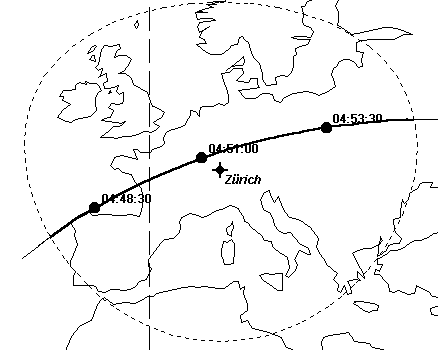
The ground track of Kosmos
929 across Europe
in the early morning of
6 August, 1977
|
So, the spectrogramme had
to be carefully examined for a period from 0447 to 0454 UT that morning.
As can be seen from the spectrogramme below, there certainly was a trace
on the film during that period (See the trace between the two red arrows).
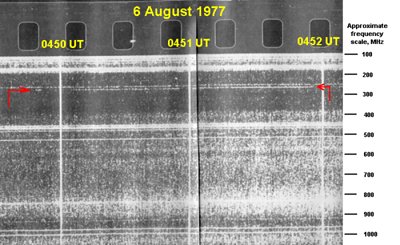
Click on the picture to
see an enlarged version
|
If one plots the time when
the signal appears in this spectrogram against time in an elevation-time
plot, one can see that the signal is stronger before and slightly after
Closest Approach (CA).
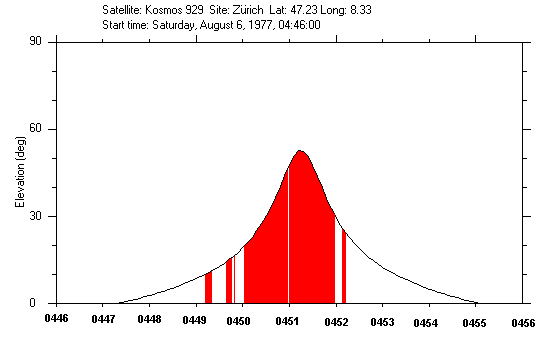
Dick and I spent several
hours analyzing the spectrogramme both for 6 August, 1977 but also for
the following day (see spectrogramm below).We had frequency data for the
"fixed interference sources" at Zürich and we finally came up with
the frequency 250 ± 5 MHz for the trace that coincided with
the pass of Kosmos 929.
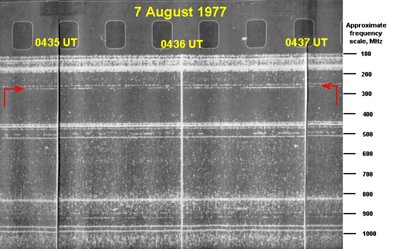
Click on the picture to
see an enlarged version
|
Since I knew that Soviet
satellites (actually the Meteor 2-series) used 248 MHz, we concluded that
Kosmos 929 transmitted on or near this frequency. We only had to wait for
the next such spacecraft, but it had been 3½ years since Kosmos
929. Was this flight just a single, freak, event? Unknown to us the next
flight of this type of spacecraft was very near!
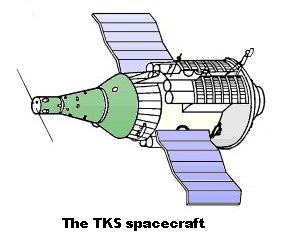 Kosmos
1267 - confirmation!
Kosmos
1267 - confirmation!
On 25 April 1981 Kosmos 1267
was launched. This craft was almost a copy of Kosmos 929, a TKS spacecraft
, which was part of the original Almaz space station concept developed
by the Chelomei design bureau. On the second day in orbit I picked up wide-band
FM telemetry on 247.0 MHz, neatly confirming the spectrogramme analysis.
A detailed account of the radio signals from the TKS craft can be read
in the article entitled "Radio Observations
of TKS and Related Flights".

 Back
to Space Tracking Notes
Back
to Space Tracking Notes






 Kosmos
1267 - confirmation!
Kosmos
1267 - confirmation!